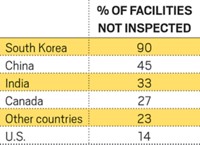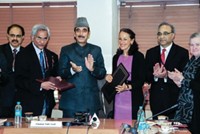Advertisement
Grab your lab coat. Let's get started
Welcome!
Welcome!
Create an account below to get 6 C&EN articles per month, receive newsletters and more - all free.
It seems this is your first time logging in online. Please enter the following information to continue.
As an ACS member you automatically get access to this site. All we need is few more details to create your reading experience.
Not you? Sign in with a different account.
Not you? Sign in with a different account.
ERROR 1
ERROR 1
ERROR 2
ERROR 2
ERROR 2
ERROR 2
ERROR 2
Password and Confirm password must match.
If you have an ACS member number, please enter it here so we can link this account to your membership. (optional)
ERROR 2
ACS values your privacy. By submitting your information, you are gaining access to C&EN and subscribing to our weekly newsletter. We use the information you provide to make your reading experience better, and we will never sell your data to third party members.
Safety
Complying with FDA
A growing number of Asian pharmaceutical chemical producers take steps to meet U.S. standards
by Jean-François Tremblay
September 25, 2006
| A version of this story appeared in
Volume 84, Issue 39

For managers of pharmaceutical facilities, few events are more unnerving than an inspection conducted by officials from the Food & Drug Administration. Everywhere, elation follows for managers of plants that get a passing grade from the feared agency whereas failure is a serious blow to one's reputation. But exactly how FDA carries out its thorough inspections depends on whether the plant is in the U.S. or overseas.
In 2002 and 2005, U.S. officials inspected a pharmaceutical ingredients plant operated by Nicholas Piramal near Hyderabad, India. "The first inspection in 2002 was the most difficult; we were very nervous," recalls J. C. Saigal, a recently retired Nicholas Piramal executive. The company passed without difficulty.
The inspectors "went into more details the second time, in 2005, but we knew better what to expect and we had everything ready," Saigal adds. He expresses particular pride that, after the second inspection, the U.S. officials asked for photocopies of the company's standard operating procedures to show to other firms trying to meet FDA standards.
Things have not been going so well for Ranbaxy Laboratories, another prominent Indian drug company. Earlier this year, following an inspection at a plant in Paonta Sahib, India, FDA mailed the firm one of its dreaded warning letters. The agency issues hundreds of warning letters annually to companies both within and outside the U.S. citing them for violations of its current Good Manufacturing Practices (cGMP) standards. These are the regulations and guidance documents that FDA uses to regulate and assess the manufacturing processes, record keeping, training standards, and equipment used by pharmaceutical producers.
In Ranbaxy's case, the agency found that the plant deviated from cGMP in several ways. It told the company that Ranbaxy products might be barred from the U.S. market if the company failed to take steps to address the agency's concerns. And approval of new finished dosage products made at Paonta Sahib would be withheld until a new inspection had shown that the problems were corrected. FDA and Ranbaxy both declined to be interviewed for this article.
As part of its mandate to protect U.S. citizens, FDA inspects overseas plants that produce pharmaceutical ingredients and finished drugs for sale in the U.S. Asian producers, particularly in China and India, supply a growing share of the drugs consumed in the U.S. and are therefore increasingly visited by FDA officials.
Since 2001, FDA has performed "systems-based" or "facilities" inspections, rather than "product" inspections. This policy means that inspectors look more at how a plant manages its entire production process than at how it produces particular drugs. As a result, plants abroad are now visited every three years or so, rather than every time they start producing a new pharmaceutical ingredient.
Jo Shen, president of the pharmaceutical ingredients producer ScinoPharm, says she would like FDA inspectors to come to her Taiwanese company more often. The firm was inspected in 2001 and 2005, she says, and because inspectors found little wrong, the agency seems to have placed a low priority on a return visit. But buyers of pharmaceutical ingredients prefer to purchase from plants that have been recently inspected, she says.
Shen, who spent many years in the U.S. drug industry before cofounding ScinoPharm, was pleasantly impressed by the FDA officials. "I get the impression that we have dealt here with inspectors more experienced than the average for the U.S." she says. They were courteous, she adds, and some displayed a genuine interest in Asian cultures.
Peter Saxon, a New Jersey-based consultant in process management, engineering, and regulatory affairs, is also interested in Asian cultures. He speaks surprisingly good Chinese for someone who doesn't live in China and didn't formally study the language. The reason is that for the past seven years, Saxon has advised companies, mostly in Asia, on how to prepare for an FDA inspection.
Saxon spends a few months every year in China, he says, and so far has advised 15 of the 60 or so Chinese companies with production sites that have received FDA approval. Before launching his consultancy in 1993, Saxon managed pharmaceutical facilities in various countries for what was then Ciba-Geigy.
The cordiality Shen experienced is different from what companies in the U.S. encounter, Saxon says. Domestically, FDA has a more "aggressive" approach to the inspection process, almost a presumption that the company being inspected is trying to conceal misdeeds, he explains. The inspectors' approach abroad appears more collaborative.
"I think the inspectors want to avoid giving the impression that FDA is an unofficial trade barrier for the U.S. or that FDA stands between U.S. patients and cheaper drugs," he says.
According to Saxon, the inspectors that the agency sends abroad are more experienced on average. They are selected from a narrow pool of about 200 or 300 inspectors who meet certain criteria. They must also have proven themselves as inspectors within the U.S and must have the permission of their regional FDA office to temporarily join the foreign inspections team.
In the U.S., FDA inspects pharmaceutical plants almost every year, arriving without warning. Abroad, inspectors make an appointment at least six weeks ahead of time. Saxon says inspectors need to schedule their visits when heading abroad to ensure that all the key people they want to talk to are present.
Six weeks is far too short a time for a company to cover up operating deficiencies, Saxon insists. If problems exist, the inspection team will uncover them even if the company has had months to prepare, he says.
A foreign inspection typically lasts four days, Saxon says, with inspectors devoting half of the first day to meetings and half of the last day to writing up their findings and recommendations. There are normally two inspectors, unless the agency has reason to expect problems with the facility. In contrast, U.S. inspections are open-ended, lasting as long as six months in exceptional cases. The number of officials taking part also varies.
Another variation between foreign and domestic practices is that inspectors share their main observations with foreign plant managers and inform them as to whether they will recommend approval. Although U.S. plant managers can often guess the mood of inspectors, they are typically not informed of the main points of the inspectors' report until they are officially informed.
On the basis of his overseas experience, Saxon observes that FDA inspectors are more likely to forgive "ignorance" than "arrogance." He ascribes ignorance to situations in which an inspector discovers a deviation from cGMP but is convinced that the plant's managers didn't know the relevant rule. Arrogance, on the other hand, is a situation where the inspector can only conclude that the plant's managers know the relevant rules but choose to ignore them.
Nicholas Piramal's Saigal says complete candor is required when going through an FDA inspection. The candor must permeate the organization, he says, and can only be the result of management's effort to promote it. "If there is any deviation from the standard operating procedures, the operator who is responsible must stand up and say, 'Yes, this happened, and I did this,'" Saigal says. "The moment you hide something, you create a suspicion in the minds of people."
In this respect, Saxon notes, managers of plants that are undergoing their first FDA inspection can more convincingly plead ignorance than managers of plants that have been inspected before.
Sunil Deshmukh, the quality assurance manager of Nicholas Piramal's Hyderabad facility, recalls that during the plant's second inspection, one FDA official asked for printouts of two-year-old stability data for several products and then compared the data in the main system with the data in the backup system.
When that was done, the inspector took a product sample and asked two Nicholas Piramal chemists listed as having performed the tests in the past to perform the same test on his sample in front of him. Deshmukh says many employees were asked to demonstrate knowledge of their jobs during the second inspection.
It took two years for Nicholas Piramal to prepare for its first FDA inspection, Saigal says. The company took advice from Saxon and from consultants in India. It modified its processes and production equipment. Many employees were retrained. A big change was to establish new procedures for keeping the plant's quality assurance manager informed of all changes to the plant, as cGMP requires.
Saxon says it takes at least 15 months to get a plant that's already in good shape ready for an FDA inspection. He visits his clients for a few days every six weeks and asks them to implement his recommendations between his visits. "The clients always think it won't take 15 months," he says, "and they're always wrong." Saxon says he drops companies that don't follow his program.
This isn't often necessary for Chinese companies that are determined to win regulatory approvals. Saxon recalls an incident when an inspector from the Australian government found that a particular Chinese plant operator had not followed standard operating procedures, jeopardizing the company's chance of obtaining an Australian approval. Management summarily fired the worker and expelled him from the plant. "The Chinese will do whatever is needed to pass an inspection," he says, adding that the plant was approved.
U.S. officials will travel to China a lot more in coming years, Saxon predicts. So far, India has about 75 FDA-approved plants, the largest number outside the U.S. But of the 6,000 or so pharmaceutical plants in China, he estimates that 600 potentially will gain FDA approval in the years ahead.




Join the conversation
Contact the reporter
Submit a Letter to the Editor for publication
Engage with us on Twitter